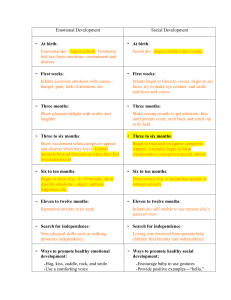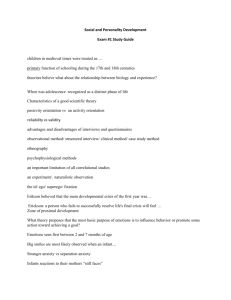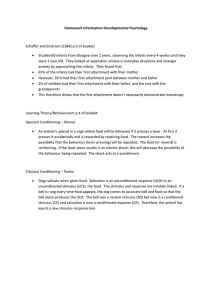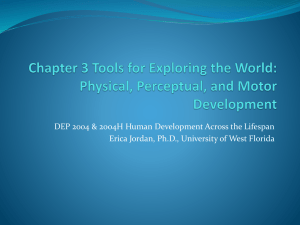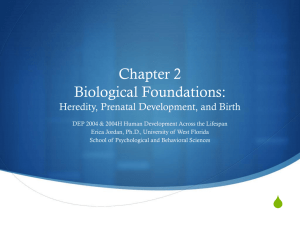HDChap4Student
advertisement
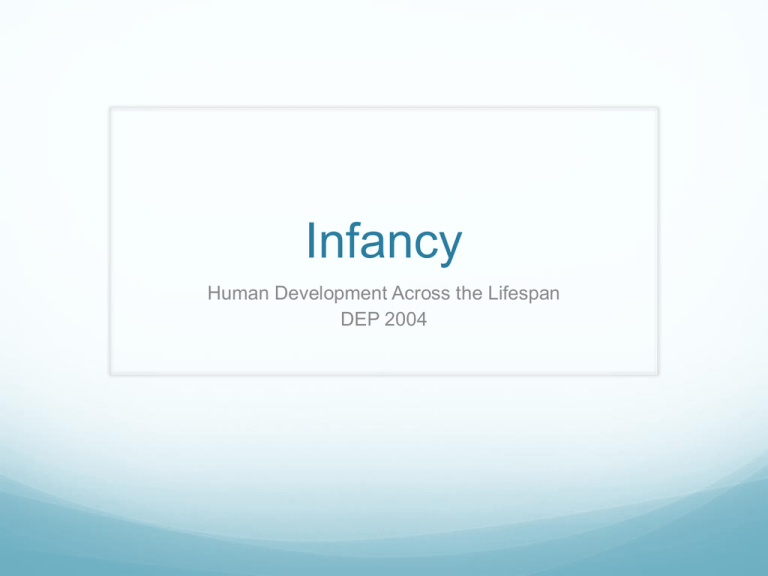
Infancy Human Development Across the Lifespan DEP 2004 Guiding Questions What is brain plasticity? How do infants think and understand? How do infants develop emotions? How do infants use the emotions of other people? Emerging Nervous System Neuron - basic cellular unit of brain and nervous system specialized In receiving and transmitting information Cell body - center of neuron that keeps it alive Dendrite - end of neuron that receives information Axon - tubelike structure that emerges from cell body and transmits information to other neurons Adapted from Kail & Cavanaugh’s Human Development: A Life-Span View, 5th Ed. Emerging Nervous System Terminal buttons - small knobs at the end of the axon that release neurotransmitters Neurotransmitters - chemicals released by terminal buttons that allow neurons to communicate Cerebral cortex - wrinkled surface of brain that regulates many functions distinctly human Hemispheres - right and left halves of cortex Corpus collosum - thick bundle of neruons that connects hemispheres Frontal cortex - brain region that regulates personality and goal-directed behavior Adapted from Kail & Cavanaugh’s Human Development: A Life-Span View, 5th Ed. Emerging Brain Structures Neural plate - group of cells present in prenatal development that becomes brain and spinal cord Myelin - fatty sheath that wraps around neuron and enables them to transmit information more rapidly Synaptic pruning - gradual reduction in number of synapses, beginning in infancy, continuing until early adolescence Adapted from Kail & Cavanaugh’s Human Development: A Life-Span View, 5th Ed. Brain Plasticity Neuroplasticity – extent to which brain organization is flexible Experience-expectant growth - process by which the wiring of the brain is organized by experiences that are common to most humans Experience-dependent growth - process by which individual’s unique experiences affect brain structures and organization Adapted from Kail & Cavanaugh’s Human Development: A Life-Span View, 5th Ed. Jean Piaget’s Perspective on Children’s Thinking Children desire to make sense of their experiences. Children construct their understanding of the world Children create theories like scientists Though these theories are incomplete, they make the world seem more predictable. Piaget’s Basic Principles of Cognitive Development Schemes: Psychological structures that organize experience. Assimilation: Taking in information that is compatible with what one already knows. Accommodation: Changing existing knowledge based on new knowledge. Equilibration: A process by which children reorganize their schemes to return to a state of equilibrium when that is broken. Jean Piaget’s Stages of Cognitive Development Sensorimotor Infancy 0-2 years Preoperational Preschool & early elementary 2-7 years Concrete Operational Middle & late elementary 7-11 years Formal Operational Adolescence & adulthood 11 years & up Stage One: Sensorimotor Infancy (0-2 years) Sensorimotor Period: First of Piaget’s stages of cognitive development, which lasts from birth to approximately 2 years. Object Permanence: understanding that objects exist independently of oneself. 8-18 months. Children’s Thought from an Information-Processing Perspective Thought involves mental hardware and mental software This combination allows children to complete a task Mental hardware—built-in neural structures that allow the mind to operate Mental software—mental “programs” that are the basis for performing particular tasks • As children develop their mental software is more complex and efficient • Development of thought is viewed as relatively continuous • Cognitive processes such as attention, learning, and memory become more sophisticated as children develop Attention—processes that determine which info. will be processed further Orienting Response--an individual views a strong or unfamiliar stimulus, and changes in heart rate and brain-wave activity occur Makes us aware of dangerous situations and important events Habituation--the diminished response to a stimulus as it becomes more familiar Helps us to preserve our cognitive resources Learning When an infant is born they already have the mechanisms that help them learn from experience Some forms of learning are: -Habituation (mentioned earlier) -Classical Conditioning -Operant Conditioning -Imitation Classical Conditioning A form of learning that involves pairing a neutral stimulus and a response originally produced by another stimulus Gives infants a sense of order They learn that a certain stimulus is a signal for what is going to happen next Infants more often show classical conditioning when the stimulus is associated with something good and less likely with something unpleasant Operant Conditioning Focuses on the relation between the consequences of behavior and the likelihood that the behavior will recur When a child behaves a certain way and is met with a positive consequence for that behavior, the child will most likely act that way again When the child’s behavior has an unpleasant consequence they are less likely to repeat what they did Imitation Older children, adolescents, and young adults learn a lot just by watching others perform a task There is even some evidence that infants may imitate facial expressions Memory Young babies can remember events for days or weeks at a time Rovee-Collier’s experiment shows that there are 3 important features exist at 2-3 months: 1.) an event from the past is remembered 2.) over time, the event can no longer be recalled 3.) a cue can serve to dredge up a memory that seems to have been forgotten Learning Number Skills Infants have basic number skills even before they know the names of numbers. They experience variations in numbers everyday • An infant learns that quantity is one of the ways that their world differs • Experiments have shown that babies can even perform simple addition and subtraction Learning Number Skills Cont’d • Also infants have shown to be able to compare quantities • 6 month olds are sensitive to ratio’s. When shown stimuli that features two blue circles for every yellow circle they will look longer when they are shown four blue circles for every yellow circle next • When adults placed two crackers in one container and three crackers in the next, the baby reached for the one with three crackers Erikson’s Early Stages of Psychosocial Development Stage 1: Trust vs. Mistrust Infancy (Birth to 1 year) Goal to obtain hope— healthy balance between openness and caution Development of Basic Emotions Social Smiles - smile that infants produce when they see a human face Stranger Wariness - first distinct signs of fear that emerge around 6 months of age when infants become wary in the presence of unfamiliar adults Complex Emotions & Later Developments Complex emotions usually emerge between 18 and 24 months of age Not universally expressed in similar ways Various experiences contribute to emotions Cultural context plays a large role in emotional expression Measuring Emotions Facial expressions are strong indicators of emotions Some evidence we are biologically programmed to express basic emotions Similarities between adults’ and infants’ expressions of emotions Recognizing and Using Other’s Emotions Social Referencing Behavior in which infants in unfamiliar or ambiguous environments look at an adult for cues to help them interpret the situation
